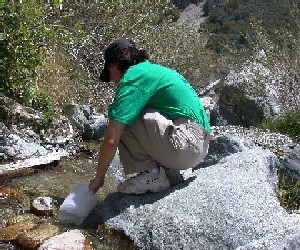|
BOB SIMONSON, Program Leader
QUANTIFYING FECAL COLIFORMS Kim Clarkin , Project Leader |
||

San Dimas Technology
& Development Center
444 E Bonita Ave
San Dimas, CA 91773
(909) 599-1267
| Incubators | QA/QC | Batteries & Inverters |
QUALITY ASSURANCE/QUALITY CONTROL
![]() Any sampling project should have a clear statement of objectives and a sampling and analysis plan designed to accomplish those objectives. It should also have a QA/QC plan that lays out how the accuracy of the results will be assured. The QA/QC plan should say how many check samples will be run at what intervals, and what type of check samples they will be.
Any sampling project should have a clear statement of objectives and a sampling and analysis plan designed to accomplish those objectives. It should also have a QA/QC plan that lays out how the accuracy of the results will be assured. The QA/QC plan should say how many check samples will be run at what intervals, and what type of check samples they will be.
Check sample types include blanks(distilled water) and split samples. Every sample set should include at least one blank to verify whether any of the materials are contaminated.
Figure 25. Technician Sampling
in San Dimas Canyon. 
At some interval, perhaps once every 10-20 samples, run one or more duplicates. Also establish how frequently you will send one or more duplicates (splits) to an outside lab.
To collect duplicate samples, collect a large amount of water in a sampling bucket. Hold the bucket upside-down over the water, upstream, and plunge it under the surface. Then, invert the bucket to collect water from the middle of the water column. Rinse the bucket thoroughly with this water, and then dump it out downstream. Rinse and dump twice more before collecting the water that will provide the sample. This rinsing process precontaminates with the target water and ensures that no lingering materials from previous sites or cleaning solutions will impact the results. Then, pour splits into the containers for field processing and for the water quality lab.
You may want to process more than one blank and split yourself, and send more than one each to the certified lab. Label one split with the correct sampling time, date and location. Consider labeling another split and blank with a false time, date and location so that the duplicates will be ‘blind’. The idea is that the lab should not know that the samples are actually splits, or that one of them is a blank. Be sure your own notes are clear about how splits are labeled.
When working with outside labs, it is important to be specific about the type of test that should be performed. Many labs deal mostly with drinking water, and they may not be accustomed to the tests for ambient waters. Be specific about what test you want them to use. Ideally, they should run the same test as you are running. If the lab cannot run the multiwell enzyme substrate test, a membrane filtration test will yield results more comparable to Colilert than a multiple tube fermentation (MTF) test. In addition to discussing this with the lab, write the desired procedure on the sample Chain-of-Custody sheets. Once the results come in, compare the field and lab numbers.
Multiple Tube Fermentation Test
This test (Standard Methods 9221) is EPA-approved for counting total coliforms, fecal coliforms, and E. coli in recreational waters, and our contract labused it as a standard practice. Three sets of five tubes each are filled with nutrient medium.
Each set of five is inoculated with different volumes of sample. The tubes are incubated, and gas production or a yellowish color in any of the tubes flags it as a presumptive positive. All presumptive positive tubes are subjected to a confirmation phase in which the number of tubes with 1) fecal coliforms and 2) E.coli can be distinguished by either gas production or fluorescence (APHA 1998).
With MTF, as with the Colilert method, there is no way to know exactly how many bacteria of a given type are reacting in a tube. The production of gas indicates that the organism is present in that tube, but the gas may have been produced by two or ten bacteria. Results for this test are therefore reported as the most probable number (MPN) of bacteria per 100 ml sample, rather than as an exact count.
Unlike the Quanti-Tray confidence limits, the 95% confidence limits of the 15-tube MTF method are quite large. For example, for an MTF test with 10 mL, 1 and 0.1mL dilutions in each of the 3 sets of 5 tubes, one result might be a MPN of 23. The lower 95% confidence limit for that result would be 9.0, and the upper limit would be 86 (APHA 1998, section 9222B). In clean waters when we are attempting to verify compliance with State standards, this wide range in the density estimate is not acceptable.
The broad range is also unacceptable when we are trying to verify the results of our own field tests. In the case of fecal coliforms, the membrane filtration test yields a unique number of colonies. In the case of E.coli, even though the multiwell enzyme substrate test produces a most probable number, it has much narrower confidence band because it uses many more wells (corresponding to tubes).
.


